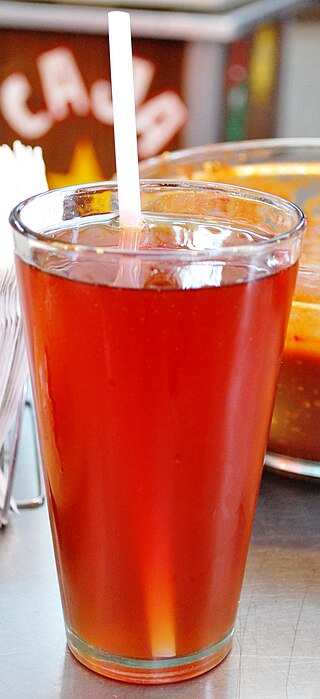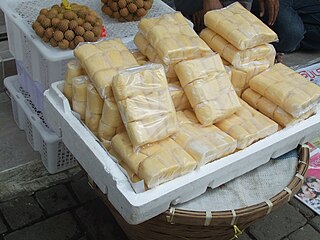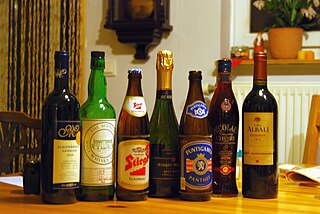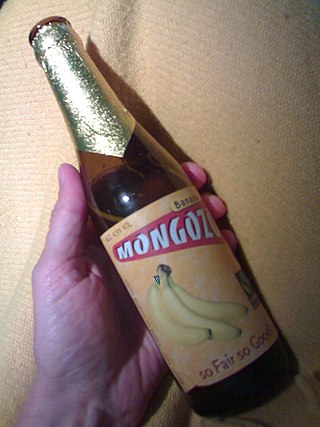Related Research Articles

Kombucha is a fermented, lightly effervescent, sweetened black tea drink. Sometimes the beverage is called kombucha tea to distinguish it from the culture of bacteria and yeast. Juice, spices, fruit or other flavorings are often added.

Chicha is a fermented (alcoholic) or non-fermented beverage of Latin America, emerging from the Andes and Amazonia regions. In both the pre- and post-Spanish conquest periods, corn beer made from a variety of maize landraces has been the most common form of chicha. However, chicha is also made from a variety of other cultigens and wild plants, including, among others, quinoa, kañiwa, peanut, manioc, palm fruit, rice, potato, oca, and chañar. There are many regional variations of chicha. In the Inca Empire, chicha had ceremonial and ritual uses.

Mbege is a kind of banana drink traditional to the Chagga ethnic group of Tanzania located in Kilimanjaro region. It is an alcoholic drink made from fermented bananas. The process of making of mbege is labor-intensive and time-consuming as the majority of the process is done by hand without the aid of modern technology. The initial taste of mbege is said to be sweet and is followed by a slightly sour aftertaste.

Kilju is the Finnish word for home made alcoholic beverage typically made of sugar, yeast, and water. The ABV is around 15–17%, and since it does not contain a sweet reserve it is completely dry. Crude fermented water may be distilled to moonshine. Kilju for consumption is clarified to avoid wine fault. It is a flax-colored alcoholic beverage with no discernible taste other than that of ethanol. It can be used as an ethanol base for drink mixers.

Makgeolli, sometimes anglicized to makkoli, is a Korean alcoholic drink. It is a milky, off-white, and lightly sparkling rice wine that has a slight viscosity, and tastes slightly sweet, tangy, bitter, and astringent. Chalky sediment gives it a cloudy appearance. As a low proof drink of six to nine percent alcohol by volume, it is often considered a "communal beverage" rather than hard liquor.
Purposeful production of alcoholic drinks is common and often reflects cultural and religious peculiarities as much as geographical and sociological conditions.

Ugandan cuisine consists of traditional and modern cooking styles, practices, foods and dishes in Uganda, with English, Arab, and Asian influences.

Waragi is a generic term in Uganda for domestic distilled beverages. Waragi is also given different names, depending on region of origin, the distillation process, or both. Waragi is known as a form of homemade Gin. The term "Waragi" is synonymous with locally distilled gin throughout Uganda. However, Uganda Waragi is a particular brand of industrially distilled gin produced by East African Breweries Limited. Other brands of distilled gin which are done by individuals at small scale are also available, but they are different from each other. The most common are: 1. "Kasese-Kasese" which was originally distilled in the district of Kasese in western Uganda and sold all over the country; 2. "Arege mogo" which first originated in Lira district in northern Uganda made and sold all over the country. These two brands "waragi" have different tastes and aromas. The distillation process in both cases produce highly distilled gin at the level produced industrially.

Tepache is a fermented beverage made from the peel and the rind of pineapples, and is sweetened either with piloncillo or brown sugar. It is sometimes seasoned with chili powder and served cold. Tepache is usually sold as a chilled drink by street vendors in Mexico, stored in barrels to expedite the fermentation process. It is served either in a clay mug or in a clear plastic bag with a straw inserted for easier travel. In the U.S., it is sold in juice bars or traditional Mexican restaurants within Mexican American communities of the Southwestern United States.

Tapai is a traditional fermented preparation of rice or other starchy foods, and is found throughout much of Southeast Asia, especially in Austronesian cultures, and parts of East Asia. It refers to both the alcoholic paste and the alcoholic beverage derived from it. It has a sweet or sour taste and can be eaten as is, as ingredients for traditional recipes, or fermented further to make rice wine. Tapai is traditionally made with white rice or glutinous rice, but can also be made from a variety of carbohydrate sources, including cassava and potatoes. Fermentation is performed by a variety of moulds including Aspergillus oryzae, Rhizopus oryzae, Amylomyces rouxii or Mucor species, and yeasts including Saccharomyces cerevisiae, and Saccharomycopsis fibuliger, Endomycopsis burtonii and others, along with bacteria.

An alcoholic beverage is a beverage containing alcohol. Alcoholic drinks are typically divided into three classes—beers, wines, and spirits—and typically their alcohol content is between 3% and 50%.

Banana beer is an alcoholic beverage made from fermentation of mashed bananas. Sorghum, millet or maize flour are added as a source of wild yeast.

Tejuino is a cold fermented beverage made from corn and popularly consumed in the Mexican states of Jalisco, Colima, Nayarit and Oaxaca. Tejuino is usually made from corn dough, the same kind used for tortillas and tamales. The dough is mixed with water and piloncillo and boiled until the liquid is very thick. The liquid is then allowed to ferment very slightly. The resulting drink is generally served cold, with lime juice, a pinch of salt and a scoop of shaved ice or lime sorbet.

The cuisine of Rwanda is based on local staple foods produced by the traditional subsistence-level agriculture and has historically varied across different areas.

Banana wine is a fruit wine made exclusively from bananas. In Tanzania, banana wine is made commercially by fermenting peeled, mashed, ripe bananas and sugar. Water, wine yeast and sugar is added to the "banana mash".

Also known as Kpete, Kwete is the alcoholic beverage brewed particularly by the Lugbara people of Uganda, Abanyala ba Kakamega in Kenya and DR Congo. The production process involves mixing fermented sorghum, millet or maize, malt, boiled water and yeast which is locally called Aku fi.
Khao mak, also known as "Thai fermented sweet rice dessert", is a Thai dessert. The sticky rice used to prepare khao mak is fermented for several days, resulting in an alcohol content of just over one percent. It has a noticeable alcohol flavor with a sweet taste and is often packaged in banana leaves.

Geist is a distilled beverage obtained by maceration of unfermented fruit or other raw materials in neutral spirits, followed by distillation. This differs from fruit brandy, where the alcohol comes from fermenting the fruit's naturally occurring sugars. As such, geist can be made from a much wider range of materials, as it is not limited to fruits with sufficient fermentable sugars.
References
Global Status Report on Alcohol 2004, World Health Organization, 2004.
